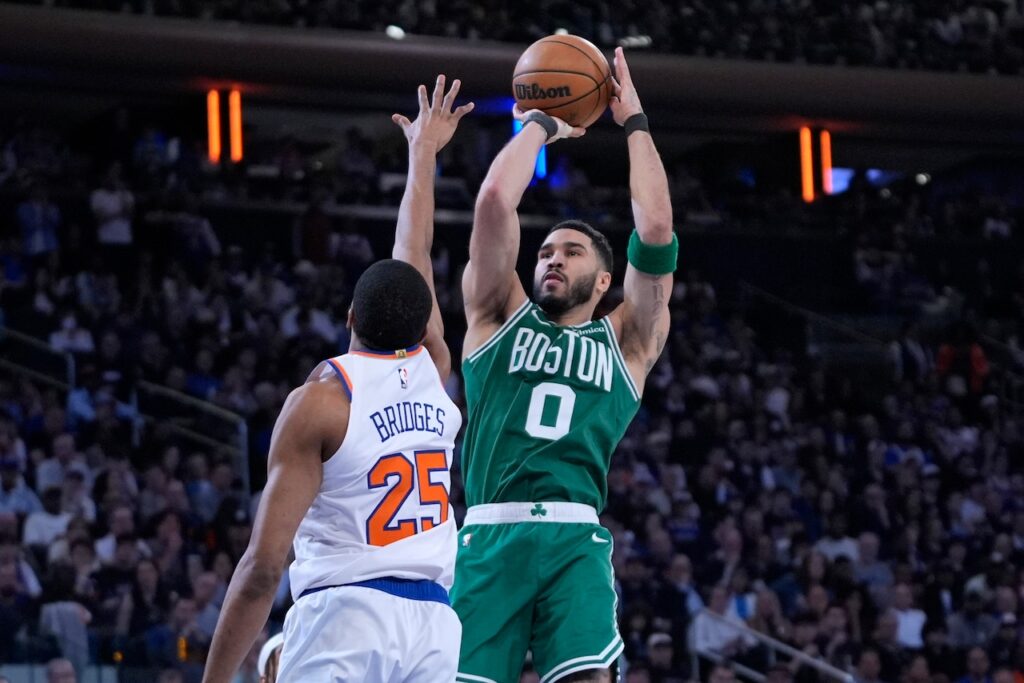It was hard to recognize in real time what moments were important during Game 3 during the Celtics’ 115-93 win over the Knicks on Saturday at Madison Square Garden.
During the first three quarters, as Boston built a big lead, it was difficult to draw real conclusions from it. The Celtics led by 20 in Game 1 and lost in overtime. They did it again in Game 2 and collapsed again.
A big lead felt much more like a reason to worry than a cause of confidence.
With 9:54 left in the fourth quarter, Jalen Brunson hit a 3-pointer to cut Boston’s lead to 20 at 99-79, causing Joe Mazzulla to call a timeout.
The moment was truly a reflection of just how much the first two games had scarred Celtics fans, because in that moment, the game didn’t actually feel safe.
But it was.
By the time what was usually crunch time came around, Boston’s lead was too big for the Knicks to overcome.
The Celtics’ defense carried them home. After New York made three of its first four shots in the final quarter, the Knicks missed 13 of their final 17, sending Spike Lee, Patrick Ewing, Ben Stiller, Tracy Morgan, John Starks and all the other Big Apple big shots home disappointed.
“Keeping our foot on the gas and playing all the way through. Not letting up. Not settling,” Jaylen Brown said. ”We did that today and that’s why the result was what it was.”
The Celtics largely controlled the defensive glass and the clock late to keep the Knicks from ever threatening.
It was a good win and certainly took the pressure off Boston and deflated New York’s swelling bravado a bit. But there’s a big question still looming out there:
Were the Celtics better overall or did they just shoot better? Those are kind of the same thing, but not completely.
There are two ways to bounce back from a loss. Create a different game plan or execute the original game plan better.
The overly-simplified version of the Celtics’ Plan A — in the game, the series and the season — was to win by making 3-pointers and playing good defense. That didn’t work in Game 1 or 2 in Boston. They shot poorly and let two winnable games get away from them, when they either didn’t or wouldn’t switch to whatever Plan B was.
Going into Game 3, they either needed Plan A to work or be ready to adapt.
The Celtics came out and made six of their first seven 3-pointers and 20 of 40 in the game. That certainly wasn’t all they did well — they guarded better, handled the ball better, etc. — but their outside shooting was the glaring difference.
In Game 2, the Celtics shot 10-for-40 from 3-point range. Ten more makes on the same number of shots was the difference between a close loss and a statement win.
“It was just a matter of time. We’re all professionals. We work really hard on our craft,” said Jayson Tatum, who had 22 points. “We put a lot of time in. You understand there are times when your shot might not be falling, but it always balances out.”
Shooting success is at the core of most players’ confidence. Making shots usually directly correlates to confidence in all areas of the game. It’s human nature.
“It’s a great feeling when your shot is falling and you feel good and confident, but that’s not the end-all be-all,” Tatum said. “There’s a lot more factors that go into the game.”
So far, it has been the end-all. The Celtics won when they shot well and lost twice when they didn’t.
Plan B can stay on the shelf for now. But what happens if the Celtics struggle shooting the ball again? That answer might never be determined, at least not in this series.
On more nights than not this year, the Celtics have shot well. They don’t have to shoot as well as they did Saturday, either. They just can’t be as bad as they were on Wednesday.
And it could get better. As well as they shot as a team, Tatum (7-for-18) and Jaylen Brown (8-for-20) were both well below their averages.
“We can shoot the ball even better and be even more aggressive. Hopefully, as we get comfortable in this series, we’ll be able to see that,” Jaylen Brown said. “You’ve got to beat us four times. There’s a lot of basketball to be played.”


